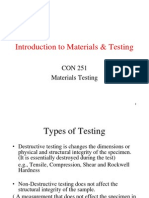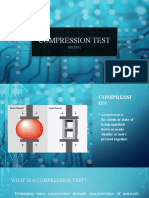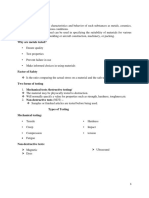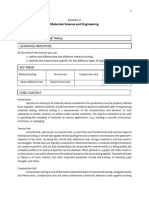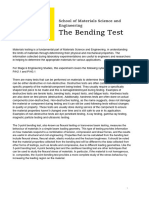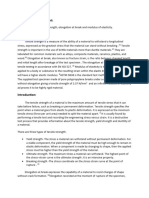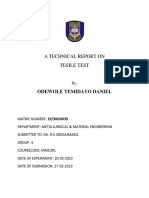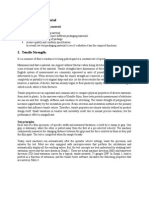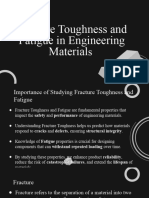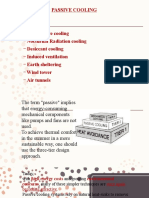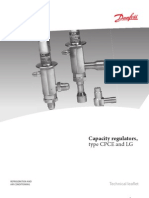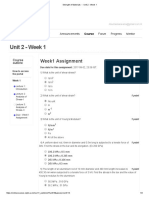0 ratings0% found this document useful (0 votes)
29 viewsNon Destructive Test
Non Destructive Test
Uploaded by
Dms〆 FrïllèxThis document discusses various types of destructive material tests:
1. Tensile tests measure a material's strength and elongation under pulling forces. Compression tests determine behavior under crushing loads.
2. Bending tests apply beam loading to measure flexural strength and modulus.
3. Torsion tests measure a material's ability to withstand twisting forces by applying torque and recording the stress-strain response.
4. Hardness tests measure a material's resistance to indentation using standardized indenters and scales. Destructive tests provide important mechanical properties data to evaluate materials and ensure safety and quality.
Copyright:
© All Rights Reserved
Available Formats
Download as PDF, TXT or read online from Scribd
Non Destructive Test
Non Destructive Test
Uploaded by
Dms〆 Frïllèx0 ratings0% found this document useful (0 votes)
29 views11 pagesThis document discusses various types of destructive material tests:
1. Tensile tests measure a material's strength and elongation under pulling forces. Compression tests determine behavior under crushing loads.
2. Bending tests apply beam loading to measure flexural strength and modulus.
3. Torsion tests measure a material's ability to withstand twisting forces by applying torque and recording the stress-strain response.
4. Hardness tests measure a material's resistance to indentation using standardized indenters and scales. Destructive tests provide important mechanical properties data to evaluate materials and ensure safety and quality.
Original Description:
Non destructive test report
Copyright
© © All Rights Reserved
Available Formats
PDF, TXT or read online from Scribd
Share this document
Did you find this document useful?
Is this content inappropriate?
This document discusses various types of destructive material tests:
1. Tensile tests measure a material's strength and elongation under pulling forces. Compression tests determine behavior under crushing loads.
2. Bending tests apply beam loading to measure flexural strength and modulus.
3. Torsion tests measure a material's ability to withstand twisting forces by applying torque and recording the stress-strain response.
4. Hardness tests measure a material's resistance to indentation using standardized indenters and scales. Destructive tests provide important mechanical properties data to evaluate materials and ensure safety and quality.
Copyright:
© All Rights Reserved
Available Formats
Download as PDF, TXT or read online from Scribd
Download as pdf or txt
0 ratings0% found this document useful (0 votes)
29 views11 pagesNon Destructive Test
Non Destructive Test
Uploaded by
Dms〆 FrïllèxThis document discusses various types of destructive material tests:
1. Tensile tests measure a material's strength and elongation under pulling forces. Compression tests determine behavior under crushing loads.
2. Bending tests apply beam loading to measure flexural strength and modulus.
3. Torsion tests measure a material's ability to withstand twisting forces by applying torque and recording the stress-strain response.
4. Hardness tests measure a material's resistance to indentation using standardized indenters and scales. Destructive tests provide important mechanical properties data to evaluate materials and ensure safety and quality.
Copyright:
© All Rights Reserved
Available Formats
Download as PDF, TXT or read online from Scribd
Download as pdf or txt
You are on page 1of 11
Destructive Test
Introduction
As the name suggests, destructive testing (DT) includes
methods where the material is broken down in order to
determine mechanical properties, such as strength,
toughness and hardness.
Advantages of Destructive Testing (DT)
• Verifies properties of a material
• Determines quality of welds
• Helps to reduce failures, accidents and costs
• Ensures compliance with regulations
TENSILE TEST
A tensile test, also known as tension test, is probably the
most fundamental type of mechanical test is performed
on a material. Tensile tests are simple, relatively
inexpensive, and fully standardized. By pulling on
something, you will very quickly determine how the
material will react to forces being applied in tension. As
the material is being pulled, you will find its strength
along with how much it will elongate.
COMPRESSION TEST
Method for determining behavior of materials under
crushing loads. Specimen is compressed, and
deformation at various loads is recorded. Compressive
stress and strain are calculated and plotted as a stress-
strain diagram which is used to determine elastic limit,
proportional limit, yield point, yield strength and (for
some materials) compressive strength.
"Axial compression testing is a useful procedure for
measuring the plastic flow behavior and ductile fracture
limits of a material. Measuring the plastic flow behavior
requires frictionless (homogenous compression) test
conditions, while measuring ductile fracture limits takes
advantage of the barrel formation and controlled stress
and strain conditions at the equator of the barreled
surface when compression is carried out with friction.
Axial compression testing is also useful for measurement
of elastic and compressive fracture properties of brittle
materials or low-ductility materials. In any case, the use
of specimens having large L/D ratios should be avoided
to prevent buckling and shearing modes of
deformation1."
The image at right shows variation of the strains
during a compression test without friction
(homogenous compression) and with progressively
higher levels of friction and decreasing aspect ratio
L/D (shown as H/D)1.
BENDING TEST
The flexure test method measures behavior of materials
subjected to simple beam loading. It is also called a
transverse beam test with some materials. Maximum
fiber stress and maximum strain are calculated for
increments of load. Results are plotted in a stress-strain
diagram. Flexural strength is defined as the maximum
stress in the outermost fiber. This is calculated at the
surface of the specimen on the convex or tension side.
Flexural modulus is calculated from the slope of the
stress vs. deflection curve. If the curve has no linear
region, a secant line is fitted to the curve to determine
slope.
A flexure test produces tensile stress in the convex side
of the specimen and compression stress in the concave
side. This creates an area of shear stress along the
midline. To ensure the primary failure comes from tensile
or compression stress the shear stress must be minimized.
This is done by controlling the span to depth ratio; the
length of the outer span divided by the height (depth) of
the specimen. For most materials S/d=16 is acceptable.
Some materials require S/d=32 to 64 to keep the shear
stress low enough.
TORSION TEST
A torsion test measures the strength of any material
against maximum twisting forces. It is an extremely
common test used in material mechanics to measure how
much of a twist a certain material can withstand before
cracking or breaking. This applied pressure is referred to
as torque. Materials typically used in the manufacturing
industry, such as metal fasteners and beams, are often
subject to torsion testing to determine their strength
under duress.
There are three broad categories under which a torsion
test can take place:
• Failure testing: it involves twisting the material
until it breaks.
• Proof testing: it is used to observe whether a
material can bear a certain amount of torque load
over a given period of time.
• Operational testing: it is used to test specific
products to confirm their elastic limit before going
on the market.
It is critical for the results of each torsion test to be
recorded. Recording is done through creating a stress-
strain diagram with the angle of twist values on the X-
axis and the torque values on the Y-axis. Using a torsion
testing apparatus, twisting is performed at quarter-
degree increments with the torque that it can withstand
recorded. The strain corresponds to the twist angle, and
the stress corresponds to the torque measured. After
testing, metal materials are categorized as being either
ductile or brittle. Ductile metals such as steel or
aluminium have high elastic limits and can withstand a
great deal of strain before breaking. Brittle materials
such as cast iron and concrete have low elastic limits
and do not require much strain before rupturing.
Without performing a torsion test, materials would not
be properly vetted before being released for industrial
use. It is of paramount importance that the ability for a
material to bear a certain amount of twisting is
accurately measured. Otherwise, structures and
machines that depend on such materials could break
down causing instability, work flow interruption or even
significant damage and injury.
• Torsion test is not widely accepted as much as
tensile test.
• Torsion tests are made on materials to determine
such properties as the modulus of elasticity in shear,
the torsion yield strength and the modulus of
rupture.
• Often used for testing brittle materials and can be
tested in full-sized parts, i.e., shafts, axles and twist
drills which are subjected to torsional loading in
service.
HARDNESS TEST:
Hardness is the resistance of a material to permanent
indentation. It is important to recognize that hardness
test is an empirical test and therefore hardness is not a
material property. This is because there are several
different hardness tests that will each determine a
different hardness value for the same piece of material.
Therefore, hardness depends on the test method and
every test result has a label identifying the test method
used.
Hardness is, however, used extensively to characterize
materials and to determine if they are suitable for their
intended use or not. All of the hardness tests described
below involves the use of a specifically shaped indenter,
significantly harder than the test sample that is pressed
into the surface of the sample using a specific force.
Either the depth or size of the indent is measured to
determine a hardness value.
Advantages of Hardness Test:
• Easy to perform
• Quick - 1 to 30 seconds
• Relatively inexpensive
• Finished parts can be tested - but not ruined
• Virtually any size and shape can be tested
The most common uses for hardness tests is to verify
the heat treatment of a part and to determine if a
material has the properties necessary for its intended
use. Establishing a correlation between the hardness
result and the desired material property allows this,
making hardness tests very useful in industrial and
R&D applications. Hardness Scales:
There are five major hardness scales:
• Brinell - HB
• Knoop - HK
• Rockwell - HR
• Shore - HS
• Vickers – HV
You might also like
- Presentation TENSILE TESTDocument17 pagesPresentation TENSILE TESTsaifulhjismail 0809No ratings yet
- Resistance & Propulsion, Including Rudder ForcesDocument101 pagesResistance & Propulsion, Including Rudder ForcesUtkarsh KumawatNo ratings yet
- Destructive TestingDocument8 pagesDestructive TestingAbdul Rehman100% (3)
- Lab Tensile UTHMDocument27 pagesLab Tensile UTHMMuhd Farhan Bin Ibrahim100% (1)
- DESTRUCTIVE TESTDocument11 pagesDESTRUCTIVE TESTmracoma95No ratings yet
- Compression TestingDocument6 pagesCompression TestingCheri Arranz ColleraNo ratings yet
- Material Testing, and Phase Diagram: Nada Ibrahim El Kafrawy Dr. Tarek Al-Mahdy Eng. Khaled Hamed Mechatronics-Y2 Sec 2Document6 pagesMaterial Testing, and Phase Diagram: Nada Ibrahim El Kafrawy Dr. Tarek Al-Mahdy Eng. Khaled Hamed Mechatronics-Y2 Sec 2nada.elkafrawyyNo ratings yet
- Altinbas University Industrial Engineering Ie258 Manufacturing Process Lab. Tension, Bending, Compression and Torsion TestDocument19 pagesAltinbas University Industrial Engineering Ie258 Manufacturing Process Lab. Tension, Bending, Compression and Torsion TestHusam JARRAR100% (1)
- Materials Engineering: Pangasinan State University Urdaneta Campus Mechanical Engineering DepartmentDocument7 pagesMaterials Engineering: Pangasinan State University Urdaneta Campus Mechanical Engineering DepartmentiamjemahNo ratings yet
- 07 - Destructive and Non-Destructive TestingDocument83 pages07 - Destructive and Non-Destructive Testingcasiobj91No ratings yet
- Material TestingDocument10 pagesMaterial Testinganne calabasaNo ratings yet
- Material LabDocument5 pagesMaterial LabNELMIDA AIRISH JOY N.No ratings yet
- Lecture 2 Mechanical TestingDocument30 pagesLecture 2 Mechanical TestingDika AnggaraNo ratings yet
- Material TestingDocument59 pagesMaterial TestingWilliam Salazar100% (5)
- Destructive TetsingDocument11 pagesDestructive TetsingneerajNo ratings yet
- JF 302 - Material Technology 1Document18 pagesJF 302 - Material Technology 1Arif AzizAnNo ratings yet
- Unit 4 - Materials Technology - WWW - Rgpvnotes.inDocument24 pagesUnit 4 - Materials Technology - WWW - Rgpvnotes.inlokeshNo ratings yet
- Mechanics SlideDocument20 pagesMechanics SlideAtikur RahmanNo ratings yet
- Lecture Notes Material Testing th1 4th Sem Srs 1708402776Document49 pagesLecture Notes Material Testing th1 4th Sem Srs 1708402776kisilusamuel63No ratings yet
- Compression TestDocument16 pagesCompression TestASTIG TVNo ratings yet
- Tensile and Hardness Testing (1706025)Document16 pagesTensile and Hardness Testing (1706025)ShowvikNo ratings yet
- Unit I - Materials TestingDocument66 pagesUnit I - Materials TestingBayu PratamaNo ratings yet
- Method of Testing: Lecture-3Document28 pagesMethod of Testing: Lecture-3Bikash ChapagainNo ratings yet
- Introduction To Materials TestingDocument6 pagesIntroduction To Materials Testinggosaye desalegn100% (1)
- Materials Lab REPORT 3Document5 pagesMaterials Lab REPORT 31803040035No ratings yet
- DT & NDTDocument46 pagesDT & NDTThulasi Ram100% (1)
- Destructive Testing 122Document7 pagesDestructive Testing 122Abu Bakar ShafiqueNo ratings yet
- Destructive TestingDocument12 pagesDestructive TestingGowriShankarNo ratings yet
- UNIT-II Mechanical Property MeasurementDocument127 pagesUNIT-II Mechanical Property Measurementlol WANo ratings yet
- Testing of Materials With A Universal Testing Machine Gate Notes 771686837008983Document6 pagesTesting of Materials With A Universal Testing Machine Gate Notes 771686837008983Somu SinghNo ratings yet
- Material TestingDocument20 pagesMaterial TestingMohd Afandy100% (1)
- Tensile Testing 8Document10 pagesTensile Testing 8Saadia AsgharNo ratings yet
- Material TestingDocument7 pagesMaterial TestingkimsonNo ratings yet
- Material Testing 1. Tension TestingDocument5 pagesMaterial Testing 1. Tension TestingcarolineNo ratings yet
- Composites TestingDocument29 pagesComposites TestingThiru Moorthy100% (2)
- SESSION TOPIC 3 - Material TestingDocument4 pagesSESSION TOPIC 3 - Material TestingEmmanuelle De MesaNo ratings yet
- 5 Mechanical TestingDocument70 pages5 Mechanical TestingLahiru JananjayaNo ratings yet
- Chap 3 - ReviewerDocument4 pagesChap 3 - ReviewerIsha MancenidoNo ratings yet
- The Process of MaintenanceDocument11 pagesThe Process of MaintenanceUsman MalikNo ratings yet
- Tensile Test of Steel BarsDocument2 pagesTensile Test of Steel BarsCeddie PamintuanNo ratings yet
- Lesson One - Plan - MaterialsDocument6 pagesLesson One - Plan - MaterialsVictor QuezadaNo ratings yet
- Anexo VI: Tensile PropertiesDocument5 pagesAnexo VI: Tensile PropertiesPsNo ratings yet
- Mechanical PropertiesDocument26 pagesMechanical PropertiesiqbalNo ratings yet
- GROUP 8 - Material Testing Written Report (MEC 0325-1)Document22 pagesGROUP 8 - Material Testing Written Report (MEC 0325-1)Fides MagistradoNo ratings yet
- Material Science Module-2: Stress Strain Curve For Ductile MaterialDocument26 pagesMaterial Science Module-2: Stress Strain Curve For Ductile MaterialKushNo ratings yet
- Laboratory Tools & EquipmentDocument20 pagesLaboratory Tools & EquipmentJerome GarganeraNo ratings yet
- TensileDocument5 pagesTensilefarhana.archi007No ratings yet
- Rheology and Testing of Polymers LabDocument79 pagesRheology and Testing of Polymers LabIBIZANo ratings yet
- Tensile Testing by Odewole TemidayoDocument10 pagesTensile Testing by Odewole Temidayostephenoladipo21No ratings yet
- Bend Test and Ductility Test 1Document25 pagesBend Test and Ductility Test 1Novie Dave EstremaduraNo ratings yet
- Test of Packaging MaterialDocument16 pagesTest of Packaging MaterialPrashanta Pokhrel100% (1)
- 1 B) Unit - Mechanical Properties & Their TestingsDocument44 pages1 B) Unit - Mechanical Properties & Their TestingsAnil ChauvanNo ratings yet
- Fracture Toughness and FatigueDocument93 pagesFracture Toughness and FatigueVanvan BitonNo ratings yet
- 2 Mechanical properties of materialsDocument39 pages2 Mechanical properties of materialsKamal SurenNo ratings yet
- Compression TestDocument18 pagesCompression TestAllen10No ratings yet
- Destructive Testing: TypesDocument26 pagesDestructive Testing: TypesIan DinglasanNo ratings yet
- Strength of MaterialsDocument11 pagesStrength of MaterialsJoseph ValenciaNo ratings yet
- Materials TestingDocument33 pagesMaterials TestinggrantarvinNo ratings yet
- Act 3 MatmatDocument4 pagesAct 3 MatmatPsalm Bethaniel MaalaNo ratings yet
- (2017) Chapter 9 (Phase Diagram)Document50 pages(2017) Chapter 9 (Phase Diagram)MohamadFajarAzzakiNo ratings yet
- 20946-Article Text-85985-2-10-20240228Document8 pages20946-Article Text-85985-2-10-20240228S_BhavanNo ratings yet
- Physics For Engineers - Unit 7 - Heat and TemperatureDocument13 pagesPhysics For Engineers - Unit 7 - Heat and TemperatureRaymart Dave MirandoNo ratings yet
- Open Channel: Classification of Open-Channel Flows Classification of Open-Channel FlowsDocument4 pagesOpen Channel: Classification of Open-Channel Flows Classification of Open-Channel FlowsLi ReNo ratings yet
- Calculation Procedure, Condensation: Exxon EngineeringDocument79 pagesCalculation Procedure, Condensation: Exxon Engineeringvin ss100% (1)
- Heat ExchangersDocument30 pagesHeat Exchangerstakis.papadopoulos6672No ratings yet
- Wa0019.Document38 pagesWa0019.asraful.adalderNo ratings yet
- FluidMech - Fluid PropertiesDocument3 pagesFluidMech - Fluid Propertiesocabonita01No ratings yet
- Unit - 03 - Passive CoolingDocument51 pagesUnit - 03 - Passive CoolingSuruthi ATKNo ratings yet
- Kanthal APM: (Resistance Heating Wire and Resistance Wire)Document3 pagesKanthal APM: (Resistance Heating Wire and Resistance Wire)asifNo ratings yet
- CFX Multiphase 14.5 L02 Modeling ApproachesDocument27 pagesCFX Multiphase 14.5 L02 Modeling Approachesedersalcedocastro100% (1)
- MEEN 30130 L2 U Values Walls Windows 2023Document31 pagesMEEN 30130 L2 U Values Walls Windows 2023Vai taapsNo ratings yet
- Analysis of Tension Members (Bolted and Riveted)Document6 pagesAnalysis of Tension Members (Bolted and Riveted)Bryle Steven NewtonNo ratings yet
- Capacity Regulator CpceDocument8 pagesCapacity Regulator CpceNovan AndriantoNo ratings yet
- Design of Small Wind Turbines PDFDocument6 pagesDesign of Small Wind Turbines PDFephremNo ratings yet
- Mass Transfer DR AurobaDocument192 pagesMass Transfer DR AurobaNagwa Mansy100% (1)
- Fatigue FractureDocument50 pagesFatigue FractureclaradwisNo ratings yet
- Pipe Flow Friction Factor CalculationsDocument13 pagesPipe Flow Friction Factor CalculationspelotoNo ratings yet
- Nptel Mechanical Engineering Refrigeration and Air Conditioning (Web)Document5 pagesNptel Mechanical Engineering Refrigeration and Air Conditioning (Web)Ankit LonareNo ratings yet
- Strength of Materials - Unit 2 - Week 1Document3 pagesStrength of Materials - Unit 2 - Week 1M.Saravana Kumar..M.ENo ratings yet
- Placas StaadDocument18 pagesPlacas StaadFcosmeNo ratings yet
- Oklahoma City Home Office: 9500 Series Pilot Operated Safety Relief Valve Sizing ProgramDocument6 pagesOklahoma City Home Office: 9500 Series Pilot Operated Safety Relief Valve Sizing Programdilema_pgNo ratings yet
- Loading Anlaysis On Continous Beam - Week 6Document20 pagesLoading Anlaysis On Continous Beam - Week 6DEBRA DEIRDRE S. ONONG DEBRA DEIRDRE S. ONONGNo ratings yet
- Petrojarl Foundation Pad Reactions Transport TransverseDocument12 pagesPetrojarl Foundation Pad Reactions Transport TransverseSukhDeolNo ratings yet
- Untitled - FHP ManufacturingDocument52 pagesUntitled - FHP ManufacturingAbdulSattarNo ratings yet
- IPE Plate 3Document29 pagesIPE Plate 3Lee Anthony ChingNo ratings yet
- Literature Review For Double Pipe Heat ExchangerDocument4 pagesLiterature Review For Double Pipe Heat Exchangerc5r3aep1No ratings yet
- Compiled 1 PDFDocument33 pagesCompiled 1 PDFJuneNeilBalacuitNo ratings yet













